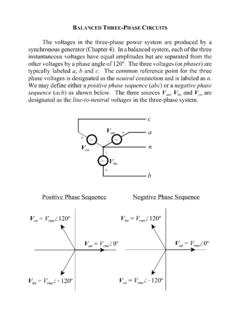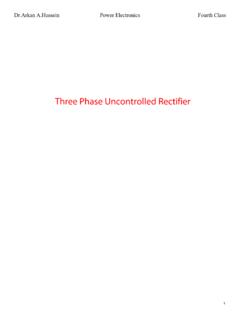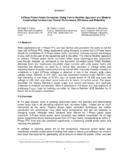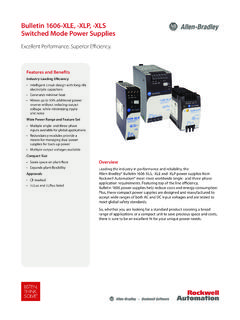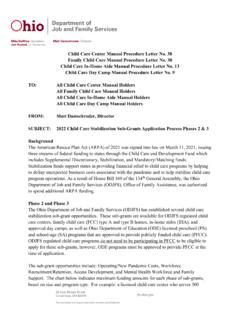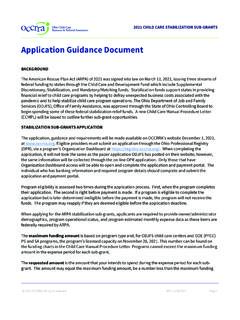Transcription of THREE-PHASE TRANSFORMERS - Mississippi State University
1 THREE-P HASE TRANSFORMERS . TRANSFORMERS used in THREE-PHASE systems may consist of a bank of three single-phase TRANSFORMERS or a single THREE-PHASE transformer which is wound on a common magnetic core. A THREE-PHASE transformer wound on a common core offers advantages over a bank of single-phase TRANSFORMERS . A THREE-PHASE transformer wound on a common core is lighter, smaller and cheaper than the bank of three single-phase TRANSFORMERS . The common core THREE-PHASE transformer also requires much less external wiring than the bank of single-phase TRANSFORMERS and can typically achieve a higher efficiency.
2 The bank of three single-phase TRANSFORMERS does offer the advantage of flexibility. In the case of an unbalanced load, one or more transformer in the bank can be replaced by a larger or smaller kVA-rated transformer. In terms of maintenance, a malfunctioning transformer in the bank of TRANSFORMERS can be easily replaced while the entire common core three- phase transformer would require replacement. The bank of single-phase TRANSFORMERS or the common core three- phase transformer can be connected in one of four combinations relative to the primary and secondary connections. Wye-Delta: Commonly used in a step-down transformer, wye connection on the HV side reduces insulation costs, the neutral point on the HV side can be grounded, stable with respect to unbalanced loads.
3 Delta-Wye: Commonly used in a step-up transformer for the same reasons as above. Delta-Delta: Offers the advantage that one of the TRANSFORMERS can be removed while the remaining two TRANSFORMERS can deliver THREE-PHASE power at 58%. of the original bank. Wye-Wye: Rarely used, problems with unbalanced loads. Wye-Delta Connection Delta-Wye Connection Delta-Delta Connection Wye-Wye Connection Note that the voltage across a wye-connected primary or secondary winding is the line-to-neutral voltage while the voltage across a delta- connected primary or secondary winding is the line-to-line voltage.
4 The magnitude of the complex THREE-PHASE power into or out of a THREE-PHASE transformer in a balanced system may be written as where Vw is the magnitude of the voltage across each winding and Iw is the magnitude of the current through each winding. In the wye-configuration, the winding voltage is the line-to-neutral voltage (VLN) while the winding current is the line current (IL). In the delta-configuration, the winding voltage is the line-to-line voltage (VLL) while the winding current is the delta current (I)). Thus, for a wye-connected winding, the magnitude of the complex power is The magnitude of the complex power for the delta-connected winding is so that the equation for the complex power for either transformer winding connection is the same given the line-to-line voltage and the line current.
5 PER-PHASE ANALYSIS OF THREE-PHASE TRANSFORMERS . Assuming the three TRANSFORMERS in the THREE-PHASE transformer are identical and the sources and loads in the THREE-PHASE problem are balanced, circuits involving a the THREE-PHASE transformer can be analyzed on a per- phase basis as illustrated in our study of THREE-PHASE circuits. As previously discussed, the easiest THREE-PHASE topology to analyze is the wye-wye connection. Thus, given any other configuration for the three- phase transformer other than wye-wye, one should transform the circuit into wye-wye form. The equivalent turns ratio for the transformed wye-wye per-phase equivalent circuit for the transformer is the ratio of the primary line-to-line voltage to the secondary line-to-line voltage for the original configuration.
6 The concept of the equivalent turns ratio can be illustrated by an example transformation of a transformer configuration. The wye-delta and delta-wye configurations of THREE-PHASE TRANSFORMERS result in 30o phase shifts between the primary and secondary line-to-line voltages. The industry standard is such that the lower voltages in these configurations should lag the higher voltages by 30o. The wye-wye or delta-delta configurations produce line-to-line voltages in the primary and secondary that are in phase. Example Transform a wye-delta THREE-PHASE transformer into the wye-wye configuration and determine the equivalent turns ratio aN of the resulting wye-wye transformer.
7 Draw the per-phase equivalent circuit for the resulting wye-wye transformer. The line-to-neutral voltages across the windings of the equivalent wye- connected secondary are found by dividing the line-to-line voltages across the windings of the of the delta-connected secondary by %& 3. Comparing the voltages and currents of the primary and secondary windings, we see the that the equivalent turns ratio of the wye-wye configuration is The equivalent wye-wye model for the wye-delta connected THREE-PHASE transformer is In a similar fashion, if we consider the transformation of the the delta- wye and delta-delta configurations to the wye-wye configurations, we find equivalent turns ratios of Example (Per-phase equivalent circuit / THREE-PHASE transformer).
8 Three single-phase 50 kVA, 2300/230 V 60 Hz TRANSFORMERS are connected to form a THREE-PHASE 4000/230 V transformer bank (these voltages are line to line) which supplies a 120 kVA, 230 V, THREE-PHASE load with a power factor of lagging. The equivalent impedance for each transformer referred to the LV winding is ( + j ) S. (a.) Determine the transformer configuration required and draw the per-phase equivalent circuit. (b.) Determine the transformer winding currents. (c.) Determine the primary voltage required to produce the rated output. (d.) Determine the voltage regulation. (a.) Individual TRANSFORMERS : Primary winding rated voltage V1,rated = 2300 V.
9 Secondary winding rated voltage V2,rated = 230 V. Turns ratio a = N1/N2 = V1,rated /V2,rated = 2300/230 = 10. 3N transformer: Primary line to line voltage V1,LL = 4000 V . 2300 %& 3. Secondary line to line voltage V2,LL = 230 V. Y-Y equivalent turns ratio aN = V1,LL/V2,LL = 4000/230 = The required transformer connection is Wye-Delta. The given equivalent impedance for each transformer is referred to the LV winding (secondary). This impedance referred to the HV. input winding is Note that the turns ratio of the individual transformer is used to reflect the impedance between the primary and the secondary.
10 The resulting wye-wye per-phase equivalent circuit is shown below. (b.) The line current delivered to the THREE-PHASE load can be found from the complex power equation: The actual current in the delta-connected secondary winding of this transformer is The corresponding current in the wye-connected primary is (c.) To determine the line-to-line voltage on the primary required to produce a secondary line-to-line voltage of 230 V, we must analyze the per-phase equivalent circuit. In the per-phase equivalent circuit, the current I2 is the secondary line current (magnitude = A). while the voltage V2 is the secondary line-to-neutral voltage (magnitude = 230/ %& 3 = V).
